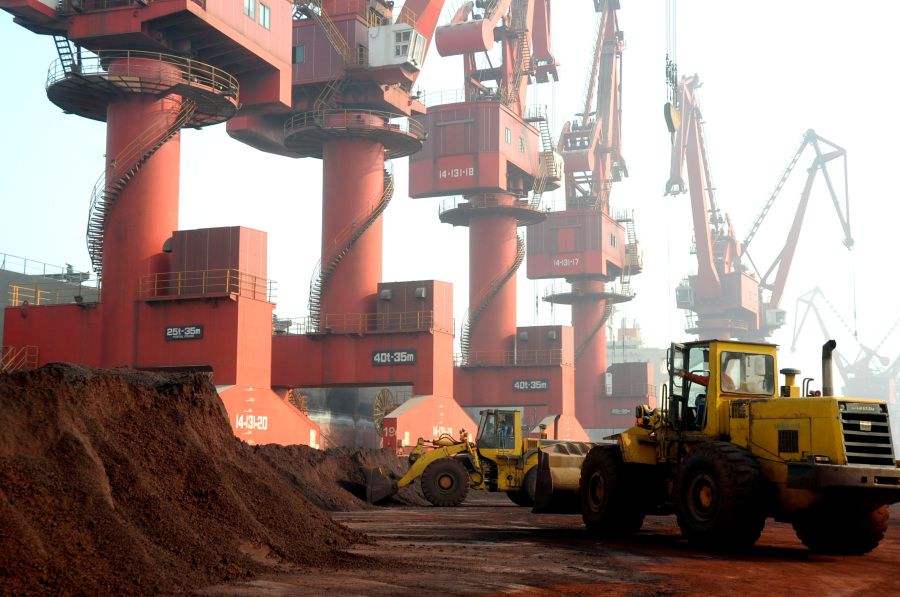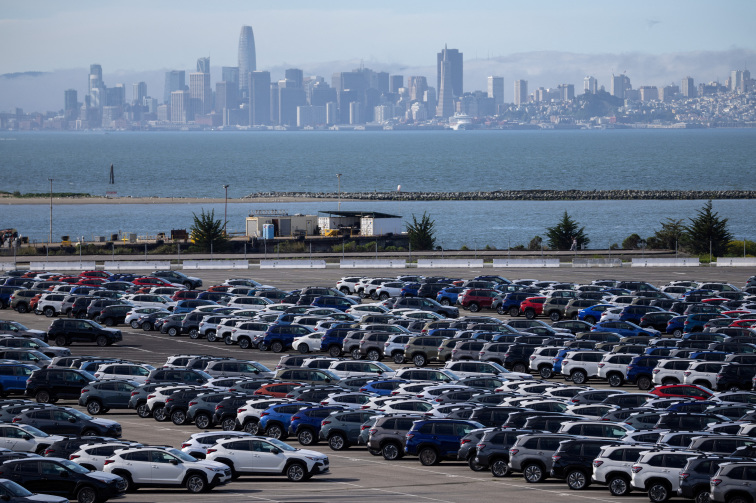Workers transport soil containing rare earth elements for export at a port in Lianyungang
[People News] On October 9, 2025, China’s Ministry of Commerce suddenly announced the implementation of the strictest export controls on rare earths in history—a move tantamount to detonating a “rare earth nuclear bomb.” It instantly ignited tensions in U.S.-China relations, geopolitics, and the global supply chain. This is more than just a trade dispute—it is a reflection of power struggles among Beijing’s top leaders on the eve of the Fourth Plenary Session of the 20th Central Committee. On the surface, it appears to be a show of geopolitical toughness toward the U.S., but behind it lies a political smokescreen launched by Xi Jinping to conceal an internal power crisis.
Rare Earth Controls: The CCP Launches the Harshest “Choke Point” Operation in History
At 9:00 a.m. on October 9, 2025, the official website of China’s Ministry of Commerce quietly released a bombshell announcement: “Decision on Implementing Export Controls on Rare Earth–Related Technologies, Document No. 62 (2025).”
The controls cover every link in the rare earth industrial chain—from upstream superhard materials and rare earth equipment, to midstream auxiliary materials and heavy rare earth separation technologies, to downstream battery materials, synthetic graphite, and composite materials. They even include rare earth products and technologies containing Chinese components abroad.
The control standard is unprecedented: any product containing more than 1% of Chinese-origin content will be subject to restrictions. This means that any company worldwide that relies on Chinese rare earths will face potential supply chain disruption.
In the past, China had adjusted export quotas for rare earths, but never in such a systematic, large-scale, and targeted manner. Previously, the CCP merely limited exports of specific items. This time, it has imposed multiple layers of restrictions—including on technologies, materials, and equipment—forming a “hybrid control model.”
According to reports from the International Atomic Energy Agency (IAEA), China controls over 90% of global rare earth supply, and nearly 100% of heavy rare earths. This move delivers a “nuclear bomb–level” blow to U.S. industries such as defense, artificial intelligence, and electric vehicles, and has also obstructed the technological strategies of Europe and Japan.
The October 9 announcement hit global financial markets like a black swan event. On the same day, the U.S. rare earth ETF (REMX) plunged 2.8%, wiping out $3 billion in market value. Shares of America’s largest rare earth mining company, MP Materials, collapsed by 12%. High-tech stocks suffered further: Qualcomm fell 2%, NVIDIA dropped 1.5%, and the Nasdaq closed down 1.2%, hitting a new low since September.
From Tactical Easing to Sudden Reversal — Hidden Dangers in U.S.-China Relations
Notably, just one week before the announcement—on September 23—senior U.S. and Chinese officials “shook hands” at the UN General Assembly. Premier Li Qiang extended an olive branch to Washington, saying China supported multilateral trade reform and was not seeking new privileges within the WTO. Earlier, Xi Jinping had also taken a softer stance on the TikTok acquisition case. Negotiations between Washington and Beijing had entered a crucial stage in September.
Bloomberg reported that both sides had even discussed “stable rare earth supply.” The International Monetary Fund (IMF) predicted that this could boost bilateral trade by 5% in 2026. Trump, confident about agricultural exports such as soybeans, was preparing to discuss the matter with Xi Jinping at the APEC summit in South Korea at the end of October.
At that time, global public opinion believed that U.S.-China relations had entered a rare “period of tactical easing,” and Trump felt proud of his geopolitical achievements. Yet Beijing reversed its stance overnight—like smiling across the negotiation table one minute and overturning it the next. The Wall Street Journal commented, “This is Beijing’s Achilles’ heel counterstrike—Washington was caught off guard.”
From a geopolitical perspective, this marks an escalation in the U.S.-China decoupling process, pushing both nations rapidly toward crisis and confrontation.
Trump was enraged. On Truth Social, he wrote: “Insidious! Beijing’s hostility will halt American factories and worsen the global economy!” He immediately retaliated, announcing a 100% tariff on Chinese goods, along with bans on Chinese software and Boeing aircraft parts.
In reality, Xi Jinping’s regime has long been pursuing its strategic vision of “the East rising, the West declining.” His previous concessions were merely tactical maneuvers—escalation and confrontation have always been the true objectives.
The CCP Has Launched Five “Killer Moves” Against the U.S. Since September
Since September, the CCP has unleashed five major “weapons” against the United States:
-
Late September: China’s Cyberspace Administration ordered a ban on Chinese companies testing NVIDIA’s RTX Pro 6000D chips and canceled tens of thousands of purchase orders, shaking global markets.
-
October 1: Beijing abruptly stopped importing Australian iron ore and demanded that Australia settle iron ore trade in yuan—aiming to weaken the U.S. dollar’s dominance and strike at U.S. capital markets.
-
October 10: China’s State Administration for Market Regulation launched an antitrust investigation into Qualcomm’s acquisition of Israel’s Autotalks, citing nondisclosure of details.
-
October 11: The Ministry of Transport announced that starting October 14, it would impose special port fees on U.S. vessels.
-
Finally: The comprehensive rare earth export ban—the fifth and most powerful move.
Something Unusual Is Happening — Xi Jinping Covers Up a Power Crisis
In the long run, U.S.-China decoupling appears inevitable, and fluctuations between the two sides are nothing new. However, this particular rare earth control move is highly unusual—the timing is too sensitive and suggests hidden motives.
At 8:30 a.m. on October 9, Premier Li Qiang boarded a chartered flight to Pyongyang to meet with Kim Jong Un. Just 30 minutes later, the Ministry of Commerce announced the rare earth ban. Over the next two days, the State Council and its ministries launched additional offensives—investigating Qualcomm and imposing special port fees on U.S. ships.
Although these countermeasures were nominally issued by the State Council, in reality they were personally planned and directed by Xi Jinping himself. Li Qiang is merely a pawn, and the ministries have no real authority to make such decisions.
On October 9, overseas independent media reported that Xi Jinping had suffered a sudden cerebral hemorrhage. On October 11, a former CCP official from Inner Mongolia revealed in his online program that the rumor had been leaked by a high-ranking insider in Zhongnanhai. Independent journalist Du Wen verified the information through multiple domestic sources, all confirming that Xi had indeed been out of sight for two or three days. Commentator Tang Jingyuan also reported that sources from a vice–national level intelligence circle confirmed Xi’s health issues—the stroke rumors were not baseless.
However, the CCP’s Xinhua News Agency announced for two consecutive days that Xi would attend the World Women’s Summit on October 13. A reasonable explanation is that the stroke incident may indeed have occurred but was not fatal—Xi could recover within days and attend the summit as planned.
Why Did Xi Choose This Moment to “Fire at the U.S.”?
Perhaps the most plausible explanation is that Xi’s move was intended to cover up the internal power struggle in Zhongnanhai and to add weight to his final battle to protect his power. Recently, rumors have been swirling that Xi might lose authority at the upcoming Fourth Plenary Session, with an increasing number of negative reports about him. Facing turmoil and a health crisis, Xi has chosen to intensify confrontation with the U.S., escalate “wolf warrior diplomacy,” and revive the Cultural Revolution–era philosophy of struggle to consolidate his political standing.
Looking back at history: Mao Zedong launched the Korean War to preserve his regime; Deng Xiaoping regained military control through the Sino-Vietnamese War. Now, Xi Jinping may be hoping to wage a “smokeless economic nuclear war” to divert domestic and international attention, conceal the growing power vacuum, and rescue himself politically.
The upcoming Fourth Plenary Session may become the flashpoint of the CCP’s internal power struggle. Whether Xi steps down could become the central focus of the meeting. The rare earth controls are clearly not the end—but rather a new beginning of U.S.-China decoupling and yet another trigger point in Xi Jinping’s power crisis.
(First published by People News)











News magazine bootstrap themes!
I like this themes, fast loading and look profesional
Thank you Carlos!
You're welcome!
Please support me with give positive rating!
Yes Sure!